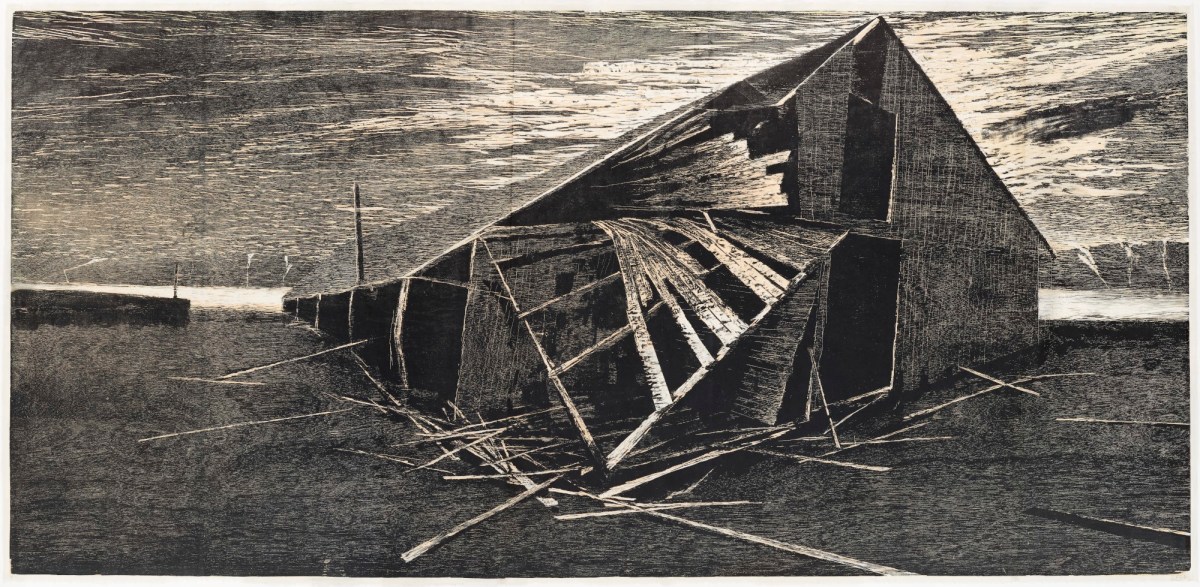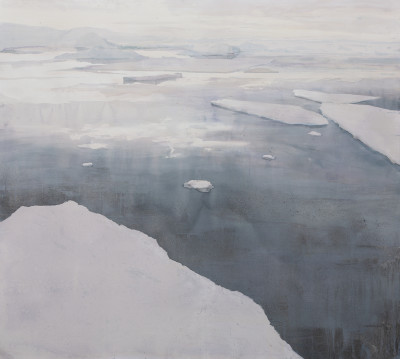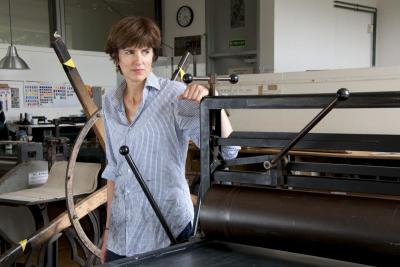
Emma Stibbon RA, Collapsed Whaling Station, Deception Island, Antarctica, 2006.
Woodcut from two blocks printed on japanese paper using oil-based ink. 1170 mm x 2380 mm. © The Artist. © Photo: Royal Academy of Arts, London. Photographer: Prudence Cuming Associates Limited.
This image is released under Creative Commons CC-BY-NC-ND
To licence this image for commercial purposes, contact our Picture Library at picturelibrary@royalacademy.org.uk
Collapsed Whaling Station, Deception Island, Antarctica, 2006
Emma Stibbon RA (b. 1962)
RA Collection: Art
“I think I’m attracted to those landscapes that have a tension between the natural forces and the manmade; particularly this place, which is really black terrain, being volcanic. I think there’s a cinematic element to the work; it has a dramatic impact that attracted me to it” (Emma Stibbon, 2017).
Emma Stibbon's work explores the impact of natural processes, phenomena and the impact of human activity on place. The Whaling Station, Deception Island depicts an abandoned station in Antarctica on an island where commercial whaling took place from the early twentieth century to the 1930s when the market for whale oil collapsed. Deception Island is the site of an active volcano, which has resulted in the collapse of the buildings and created an environment that the artist has described as “hostile”.
Stibbon describes Deception Island as “like a horseshoe of land” with a very narrow entrance protecting ships once inside. Historically, whaling took place on the island as they could process the carcasses inside the natural harbour. Stibbon has been to the Antarctic Peninsula twice on artist residencies, visiting Deception Island each time. Her process has been to make preparatory drawings and take photographs on site and then formulate the composition for a finished work in her studio. In creating prints like this one she first paints the entire block with black ink, then she draws onto it in white ink. When she is happy with the image, she cuts into the block before inking it up and finally printing onto paper.
The image is printed onto Japanese paper, which although it appears fragile due to its translucency, is in fact very strong and able to withstand the printing process. Stibbon likes the fact that the grain of the wood remains evident in the printed ink so “you really get a sense of the physicality of the material”. “It also means with wood, you can cut quite easily with the grain of the block; when you cut against the grain its quite snagging and physical. I quite like the tearing and rawness, how it determines the marks you can achieve”. Furthermore, woodcut allows her to work on a large scale. She explains “that cinematic experience, the panorama of something, the immersion of the viewer in the image, hopefully draws [the viewer] into that space”.
Woodcuts are often monochromatic being blocks of a single ink printed at a time. Stibbon made this print from two blocks: first with pink ink then black. She explains “You’re cutting out the highlights of the block so the areas that you’re cutting out become the white. I quite like that idea of illuminating the image through the cutting rather than drawing, where you’re building up tone with dark onto a white background”.
Quotes from interview with Emma Stibbon 2017
Object details
1170 mm x 2380 mm
Start exploring the RA Collection
- Explore art works, paint-smeared palettes, scribbled letters and more...
- Artists and architects have run the RA for 250 years.
Our Collection is a record of them.



